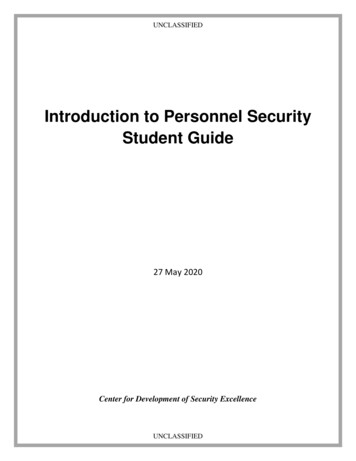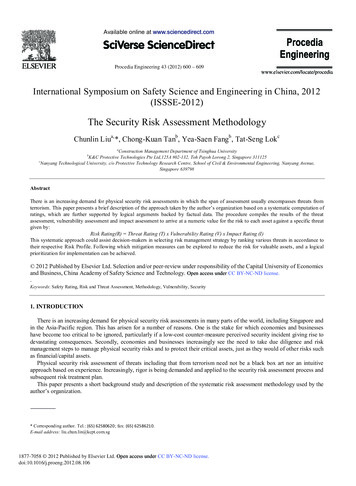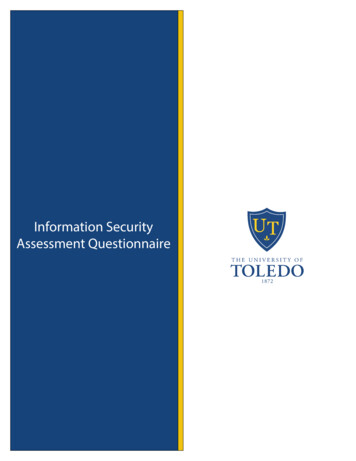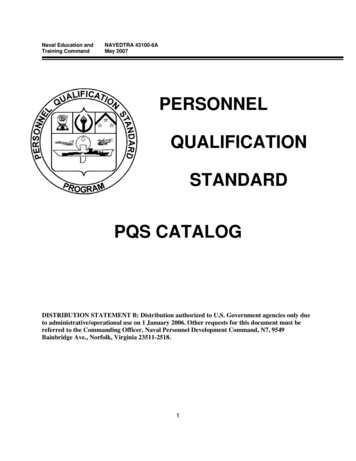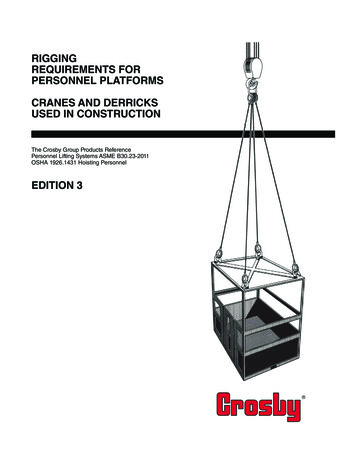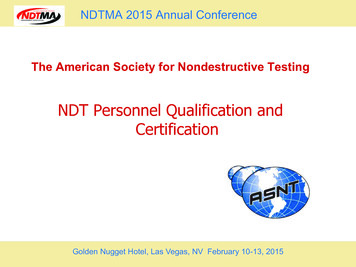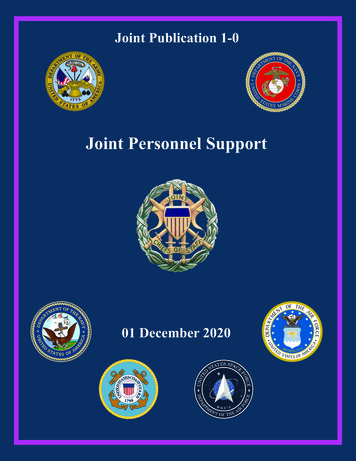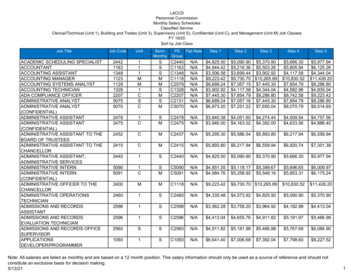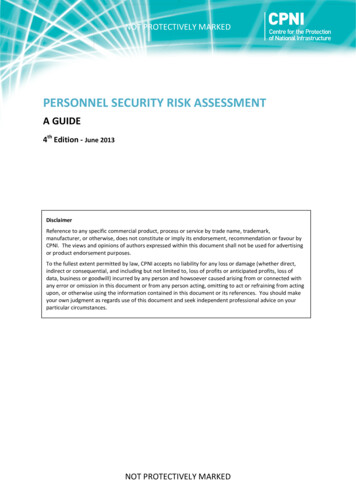
Transcription
NOT PROTECTIVELY MARKEDPERSONNEL SECURITY RISK ASSESSMENTA GUIDE4th Edition - June 2013DisclaimerReference to any specific commercial product, process or service by trade name, trademark,manufacturer, or otherwise, does not constitute or imply its endorsement, recommendation or favour byCPNI. The views and opinions of authors expressed within this document shall not be used for advertisingor product endorsement purposes.To the fullest extent permitted by law, CPNI accepts no liability for any loss or damage (whether direct,indirect or consequential, and including but not limited to, loss of profits or anticipated profits, loss ofdata, business or goodwill) incurred by any person and howsoever caused arising from or connected withany error or omission in this document or from any person acting, omitting to act or refraining from actingupon, or otherwise using the information contained in this document or its references. You should makeyour own judgment as regards use of this document and seek independent professional advice on yourparticular circumstances.NOT PROTECTIVELY MARKED
NOT PROTECTIVELY MARKEDContentsThe aim of this guidance3Personnel security3Personnel security risk assessment3Risk management in personnel security4Risk assessment: an overview5The organisation-level risk assessment7The group-level risk assessment15The role-based (individual) risk assessment18Next steps18Annex A: Blank personnel security risk assessment tables and example completed riskassessment tables19Annex B: Diagrams for use in personnel security risk assessments25Annex C: Who should be involved and where to find threat advice26NOT PROTECTIVELY MARKED2
NOT PROTECTIVELY MARKEDThe aim of this guidancePersonnel security risk assessment focuses on employees, their access to their organisation’s assets,the risks they could pose and the adequacy of existing countermeasures. This risk assessment iscrucial in helping security and human resources (HR) managers, and other people involved instrategic risk decisions, communicate to senior managers the risks to which the organisation isexposed. This guidance aims to help risk management practitioners to: Conduct personnel security risk assessments in a robust and transparent way. Prioritise the insider risks to an organisation. Evaluate existing countermeasures and identify appropriate countermeasures to mitigate thoserisks. Allocate security resources (be they personnel, physical or information) in a way which is costeffective and proportionate to the risk posed.Personnel securityPersonnel security is a system of policies and procedures that seek to manage the risk of peopleexploiting, or having the intention to exploit, their legitimate access to an organisation’s assets forunauthorised purposes. Those who seek to exploit their legitimate access are termed ‘insiders’.For the purpose of this guidance the person who causes harm to your organisation could be givenaccess to assets for one day a month or every working day, may be a permanent member of staff ora contractor and their access may be in a traditional office or site setting or via a remote means ofworking. As you work through the risk assessment the term ‘individual(s)’ and ‘personnel’ are usedto cover all people who are given legitimate access to your organisation’s assets and premises. Thismay include, but is not limited to: permanent employees, individuals on attachment or secondment,contractors, consultants, agency staff and temporary staff.Personnel security risk assessmentThis guidance explains how to use one type of methodology; it is not the only type of riskassessment but it is unique in that its focuses upon the risks posed by the people with legitimateaccess to the assets in your organisation. It is simple, robust, flexible and transparent. It can be usedalone or as an ‘add-on’ to your existing risk assessment programme. Whilst the guidance explainshow to examine the risks that people pose to your valued assets, it does not attempt to indicatewhich of those assets are the most important or which group of employees might pose the greatestthreat. This will require your own expertise and knowledge of your organisation. Each sector has itsown risks and each sector knows its business the best.This guidance is not prescriptive. It provides a framework to work with but in order for it to besuccessful it requires your organisation to bring together the right people and information. The moreyou put into this process, the more worthwhile and useful the results will be for your organisation.NOT PROTECTIVELY MARKED3
NOT PROTECTIVELY MARKEDRisk management in personnel securityThe use of appropriate personnel security measures can prevent or deter a wide variety of insiderattacks, from staff fraud through to the facilitation or conduct of a terrorist attack. However some ofthese measures can also be labour intensive and costly, and may result in delays to businessprocesses such as recruitment or movement of staff between different business areas, so it isimportant that they are implemented in a way that reflects the severity of the risk. Riskmanagement provides a systematic basis for proportionate and efficient personnel security.Risk management is the foundation of the personnel security management process and is acontinuous cycle of: Risk assessment – assessing the risks to the organisation and its assets in terms of the likelihoodof a threat taking place, and the impact that such an event might have. Implementation – identifying and implementing security measures to reduce the likelihood andimpact of the threat to an acceptable level (risk can never be 100% eradicated). Evaluation – assessing the effectiveness of the countermeasures and identifying any necessarycorrective action.The Risk Assessment process covers the Identify threats and Assess vulnerabilitiesstages of the Risk Management Cycle.The cyclical nature of the risk management process ensures that each time a risk assessment isrepeated, the implementation and evaluation stages are also reviewed. Much of the value of the riskmanagement process comes from the systematic exploration of threats, opportunities andcountermeasures through engagement with the relevant parties (these will differ betweenorganisations but may include HR, security, senior management, occupational health, informationspecialists and other technical specialists where appropriate).NOT PROTECTIVELY MARKED4
NOT PROTECTIVELY MARKEDRisk assessment: an overviewThe methodology described in this guidance defines risk as the product of two factors: the likelihoodof an event occurring, and the impact that the event would have. When each of these factors hasbeen evaluated, they are combined and this provides the overall measure of risk. In thismethodology the risk scores are relative rather than absolute and graded on a scale of 1-5 (1 is leastlikely/least impact and 5 is most likely/most impact).Likelihood of an insider event happeningThis can be broken down into three factors:Intent – a measure of the insider’s determination to carry out the attack.Capability – the degree to which an insider has the skills, knowledge and resources to be successfulin the attempt.Opportunity – a combination of the access that an insider has to an organisation’s assets (this accesswill vary depending on their role) combined with the vulnerability of the environment.ImpactThis should be considered in terms of the value of the assets affected and any wider consequences.For example, many incidents have financial, operational and reputational impact.The stages of risk assessmentThe risk assessment process: it is important to follow the risk assessment process step-by-step andnot make assumptions about the final outcomes. The risk assessment process described in thisguidance is carried out at the following levels.Organisation-level risk assessment: the organisation level risk assessment identifies the range ofinsider threats that an organisation faces and prioritises these in terms of their likelihood andimpact.Group-level risk assessment: this stage requires assessment of which groups of employees have themost access to key assets and therefore the greatest opportunity to carry out the threats identifiedat the organisation level. It also considers the capability necessary to carry out a threat; for example,would someone have to have technical knowledge or could someone with no specialist knowledgecarry out the threat. This level can reveal groups which stakeholders did not realise were involved inan area of work or indeed had access to an asset in the first place, such as senior managers, seasonalstaff or other non-regular maintenance personnel. Once this level is complete, the adequacy ofexisting countermeasures which may mitigate the risk which certain roles pose will be consideredand new ones may be suggested.Role-based (individual) risk assessment: this is an optional level which will not always be necessaryfor every organisation. It can be carried out if there are high risk roles which require their ownNOT PROTECTIVELY MARKED5
NOT PROTECTIVELY MARKEDdetailed personnel security risk assessment. This process is resource intensive and requires keypersonnel who know the role well and the access it affords. As with all risk assessments it isimportant to keep the information secure and ensure that it remains confidential; this is especiallyimportant when carrying out role-based level risk assessments.Conducting a personnel security risk assessmentWho should be involved?Risk assessments are most effective when they are an integral part of a risk management process.This helps to ensure that the risk assessment will be translated into action. Best results are achievedwhen the assessment team comprises: Staff from HR and security teams with responsibility for risk management. Individuals with deep knowledge of particular employee roles (e.g. IT managers for IT roles). Optional – a trusted external contact to provide an alternative perspective and challengereceived wisdom.To get the most out of Personnel Security Risk Assessment:The risk assessment requires discussion and indeed benefits from opinions being shared fromdifferent parts of an organisation. Enlarged reproductions of the diagrams at Annex B, togetherwith marker pens and sticky notes can help to increase participation and capture informationeffectively. You may also find it useful to nominate a scribe who captures the output fromdiscussions on a spread-sheet which can be referred to during and after the process.NOT PROTECTIVELY MARKED6
NOT PROTECTIVELY MARKEDThe organisation-level risk assessmentThe results of the organisation level risk assessment should be recorded under the followingheadings. As the risk assessment progresses, the table will be populated step by step.Insider threat Likelihood (1-5) Assumptions (likelihood) Impact (1-5) Assumptions (impact)12At the end of this process the table will provide a record of insider threats faced by yourorganisation. It is important, therefore, to protect this document in whatever form it takes as it willgive details of the vulnerabilities of your organisation. A blank table and a completed table can befound at Annex A.Step 1: Identify the potential insider threatsBefore exploring and identifying the threats to your organisation it is helpful to consider the keyfunction/s of your organisation: what must it be able to deliver or produce? This will help to identifywhich organisational assets are necessary to achieve that function.A simple example is given here:The key function of a bakery is to provide bread to its customers. The ovens and delivery vans arejust two of the key assets required to deliver this function.With your key function and key assets in mind, begin to map out the threats which face yourorganisation [see Annex C for details of where to find threat advice]. Each threat should be asspecific as possible as this will make it easier to assess the likelihood and impact. For example, thelikelihood and impact of an employee passing sensitive information to a commercial competitorthird party who then disseminates that information this may lead to one assessment. If theinformation is passed to a terrorist group or criminal the assessment of the likelihood and impactmay change.Careful definition of the threats will enable your risk assessment to produce the most useful results.The following should be considered when detailing the threats to your organisation: RangeThreats should cover the full range of insider activity which your organisation may face. This couldinclude, but is not limited to: physical attacks, theft of intellectual property, and unauthoriseddisclosure of sensitive information. The kind of threat actors or third parties which may be intent oncausing harm to your organisation may include, but is not limited to: terrorists, FIS (foreignintelligence services), criminals, single issue groups, commercial competitors, investigative mediaand former members of staff. Please see Annex C for details of who may be able to assist inassessing the threat to your organisation.NOT PROTECTIVELY MARKED7
NOT PROTECTIVELY MARKED Definition of an insiderRemember that an insider is someone who exploits, or has the intention to exploit their legitimateaccess to an organisation’s assets for unauthorised purposes. This type of risk assessment does notconsider accidental damage or threats from strangers but it may be that some measures put in placeto manage insider threats will also protect against these external threats. Level of detailAs stated above, the more detailed the threat described, the more realistic and focussed thejudgements can be about the likelihood and impact. Example threats are given here to show thelevel of detail which is useful:- An individual installs a malware virus on your organisation’s main IT system rendering itunusable for 24 hours.- An individual brings an IED (improvised explosive device)
Personnel security risk assessment focuses on employees, their access to their organisation’s assets, the risks they could pose and the adequacy of existing countermeasures. This risk assessment is crucial in helping security and human resources (HR) managers, and other people involved in strategic risk decisions, communicate to senior managers the risks to which the organisation is exposed .

